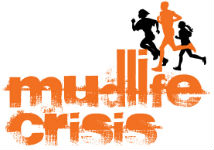I took on my second race of this season Saturday, the Indian Mud Run up in Coshocton, OH. It’s one of those races that I’ve been meaning to get to for a while and this year took the plunge. It’s also part of the Ohio OCR Grand Slam that I’m going after, and is rated one of the best 5K OCRs in the State. As I’ve mentioned before, I love the little local races almost as much as some of the big boys, and want to support them as best I can.
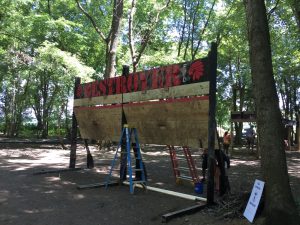
The Destroyer, built by Larry Cooper of Full Potential Obstacles.
So, you ask, how was the Indian Mud Run?
This race was created as a fundraiser for the Coshocton County Park District, and according to the starter has raised around $50,000 for the organization (which is also shared with the REACT, police, and local Boy Scouts troop that created the kids’ race) since its inception. I personally dig getting to know how well these races do at fundraising, especially when it’s a good cause. So that was nice to know.
Registration and pre-race:
The race-day info came a few days out via email, naturally, and the info was all good. Sometimes I think races give you a lot more info than you need and it can be hard to sift through it all. Or, they send you a generic message that may or may not be applicable to your wave. The pre-race info here was very appropriate. (The one question I couldn’t get an answer for before I got to the race was bag check – was there any?)
Getting to the race was easy. Parking was only $5.00, and was within easy walking distance of the registration/finish line/festival area. The final few obstacles were visible from that area, so that was kind of fun to see what you were getting into. The race was at the Lake Park in Coshocton so there was a lot of stuff available for families who might have been waiting for racers to finish. This include one of those water trampoline things where one person sits on the giant bag, the other person jumps onto the bag and launches person number one into the air!
The park was along a fairly busy highway, with parking on one side and the race/festival area on the other, but there was a tunnel under the highway that allowed for safe crossing. Nice touch.
Registration was quick and easy. Bag check turned out to be right at the registration point (as this was a fairly small race) and was free. Again, nice touch. Getting to the starting line wasn’t marked great, but the volunteers were excellent so there was really no issue there. And getting to the starting line also gave you a glimpse of what the terrain was going to be like… (insert maniacal laugh)
Race Course:
The race itself was outstanding. It was run on and around the park’s hiking trails, and was mostly single-track. Not a lot of places to run next to each other, and the waves were kept pretty small for that reason. Smart move. I think there were maybe 30 people in my wave.
When I say hiking trails, I mean the kind of hiking that I like doing – lots of opportunities to climb and descend, very picturesque, and a bit of a challenge even for the walker. The runner had his/her work cut out for him! You really had to watch where you were stepping a lot because the trail had a lot of exposed stone and roots as well as fallen logs were left in place on purpose (for the race, obviously) Occasionally you were ducking under exposed rock bluffs and crawling up them and the like. There was not a lot of actual mud – once or twice there were some puddles but aside from the couple of mud-related obstacles, the trail was fairly dry. And the markings on the course were very well done and consistently present. The race was almost entirely in the shade, which was a big plus on a hot day.
Obstacles:
The obstacles made fantastic use of the natural terrain. There were many of the standards: cargo nets, wall climbs, duck-unders, etc. in the first couple miles of the 5K race. They were obviously looking to just wear you out at the beginning. I’d say that the initial couple miles were on a par with the Spartan Sprint I ran back in May – minus the burpees, obviously. The terrain was very challenging and I love that. A lot of the climbs had ropes supplied for the ascent/descent, and they were frequently needed.
Some of the highlights of the first couple miles’ obstacles included a 30′ rope ladder (with wooden rungs) climb up the side of a cliff (with the ladder lying against the cliff), and later a similar climb but with the ladder hanging free next to the cliff. The second ladder was much harder as you tried to keep it under control while it swung free. There was a great rock-climbing/rope climb where you had a rope hanging from the top of a cliff with some very small natural footholds (small weathered holes in the rock, really). At one point you climbed up a stream that was flowing down, and as you did so you looked up to see one of the feature obstacles of the race: a trapeze net suspended over the ravine. You got to it at the top of the ravine. It was one of many mind-game obstacles in the race – you could obviously see the ravine 30-40 feet below you as you crossed, but the net was fairly tight so there wasn’t a lot of bounce to it. The height was the real factor.
Another great obstacle was the “Log Traverse”: a rope ladder climb up a cliff, from which you transferred to a horizontal log hanging from the cliff, that was suspended from a chain. The climb was about 15′, and then you traversed the log to the “dismount” point. Again, mostly a mind game after you got up there, but it was a neat one.
There were no barbed wire mud crawls, and the only real crawling obstacle was a drainage pipe-type crawl. I assume this was an effort not to chew up the trail too much for the park. Makes sense.
There was one water stop at about the halfway point. A second water stop would have been nice earlier on, but the race was short enough that with some proper preparation it wasn’t a huge factor.
Once you got to about the two mile point, you started to get into the bigger obstacles – less about the terrain and more about what someone could build. It started with a long slide down into the canal (the water wasn’t disgusting at all, just a little dark) which was refreshing on the 90+ degree day. It was a good recharge.

Not the Indian Mud Run “Dragon’s Back” obstacle, but the same concept.
The first major obstacle was the “Dragon’s Back.” This was a neat one: first, you climbed to the top of a 12′ platform. The next platform was across an approximately 8′ divide, and there was a bar attached at the top (similar to the picture to the left). You jumped across the divide and grabbed the bar, pulling yourself over the top. This was done twice. It was, again, a mental challenge to throw yourself out into the air like that.
The next obstacle was a new one to me: the “Floating Island” had as series of “bridge” pieces attached to plastic drums floating across the canal, and you had to make your way across. The bridge pieces would tilt as you made you way across, but just enough to make you uncomfortable with the tilt, so getting across wasn’t too hard if you just kept your weight distributed as much as possible.
This was followed by a fairly long rope traverse back across the canal, and then a diabolical obstacle named the “Wall Hanger”.
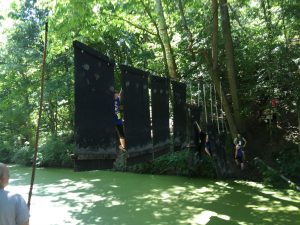
The “Wall Hanger” obstacle. A great test of grip strength and vertigo!
See the picture to the right: this was a series of planks, each about the size of a large door, with rock climbing handholds and a four-by-four block at the bottom. Each plank was free-hanging from a cable suspended across the top. You started at the far side of the canal, and made your way up to the doors going across a duckweed-covered section of the canal (yeah, it was a little grosser at this end of the canal than at the slide portion) by transferring yourself from plank to plank. It was slightly easier if you had someone your size on the other side of the plank to balance the weight a bit.
The end of the obstacle had a rope that you had to transfer to and shimmy/slide down. The handholds weren’t all helpful – some of them were attached with the actual hold pointed off to the side, so you had to experiment with which handhold was most useful to you. I saw a number of people fall on this one, and a few just bypass it altogether by swimming across. But I also got to see a lot of folks get past their fears of it and conquer this dude. Fun to watch, for sure.
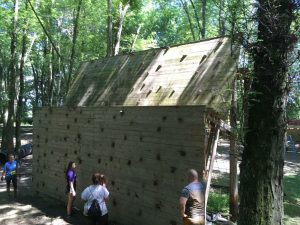
The Climbing wall – positioned just after a water slide, it was mud caked and challenging!
At that point, you had a smaller water slide to go down to get to the final few obstacles: first was a large climbing wall that had a vertical portion followed by a tilted portion (picture to the left). With its location just after the water slide, there was a lot of caked mud in the hand- and footholds which made this much more challenging than it would have been otherwise.
And it led you into a new obstacle for the race: “The Destroyer.” This obstacle was designed and built by Larry Cooper from Full Potential Obstacles, and was a real challenge to negotiate!
As you can see from the picture at the top of the page, the Destroyer is all about upper body and getting up to the point where you can use the handholds above the tilted wall. The one block on the tilt was just enough to get you up there, but you were still really challenged to get that high. There is a set of two by fours on the back to get down, in case you’re wondering – the ladders weren’t there when I went through it, obviously.
Truly simple, yet diabolical. All credit to Larry for this one! The Indian Mud Run staff told us that basically, Larry was given the materials and threw it together for the race himself – and he did a great job.
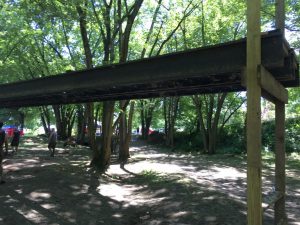
A fairly long set of monkey bars – especially for the end of a race and most especially after the Destroyer!
The Destroyer was followed by a long set of monkey bars with spinning rungs, an especially deep and clingy mud pit to get you good and nasty for finishing pictures, and then you were at the end.
All in all, this was a well-designed course. The feature obstacles were readily accessible for spectators and very challenging for competitors. There was never any fear of obstacles being unsteady (when they were supposed to be so, that is) or anything like that. And as I said earlier, it made great use of the natural terrain – often feeling like you were in a scene from Last of the Mohicans (As this is one of my favorite movies, I was extraordinarily pleased by this aspect of the race!).
Bottlenecks did happen – especially in front of the “Wall Hanger” and at a couple of the rope-climbs in the first couple of miles, as well as at the Log Traverse. But for the most part the course was well spread-out and movement was pretty consistent. Waves were small enough that it just didn’t happen that much.
Other race aspects:
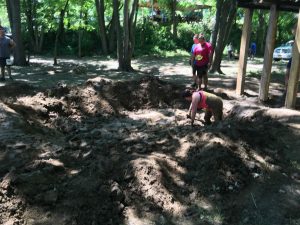
The Mud Pit – great for finishing photos and for losing shoes.
The medals were nice and big and chunky, just how we all like them. Race swag was good: lots of info about the Coshocton area, obviously, in an Indian Mud Run string backpack and an Indian Mud Run t-shirt. The shirt was pretty high-quality and had the winners of the previous year’s race on the back – a very nice touch, I thought!
Volunteers were fantastic – helpful, talkative if you wanted, and very enthusiastic about the race.
And they were proud that they’ve been keeping the feature obstacles changing from year to year, as well. They’re trying to be innovative and keep things fresh. Always a nice thing for those who run a lot of races and get burned out on the same old stuff.
The kids’ race looked fun – but there were a few kids actually in the main race, too. I was chatting with a family with kids my age that was doing the course (11 and 8) and they were having a ball. I assume there were some obstacles that they just couldn’t do from time to time because of size, but not many. It was a very family-friendly race.
There were some food vendors at the end of the race, mostly burgers and dogs and such. Prices were very reasonable.
Awards for the winners were tomahawks, apparently, which was pretty darned cool (I ran the non-competitive wave this time and didn’t see the award presentations, but I did see one of the tomahawks).
So all in all, the Indian Mud Run gets the Mudlife Crisis seal of approval. I will definitely be putting this one on my race calendar for next year.
Were you at the Indian Mud Run? What did you think? Let’s chat about it on our message board!





